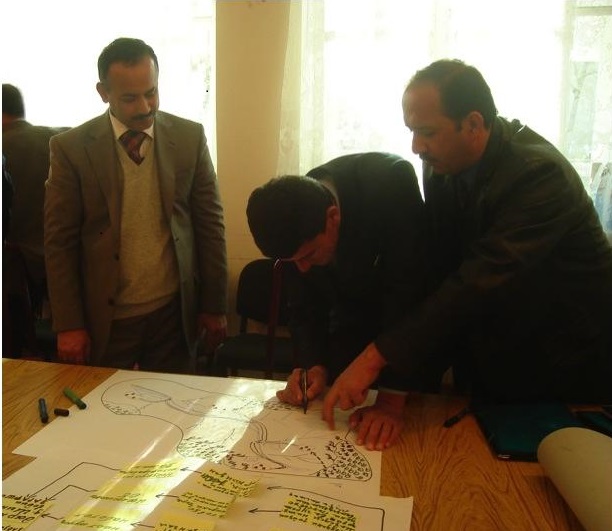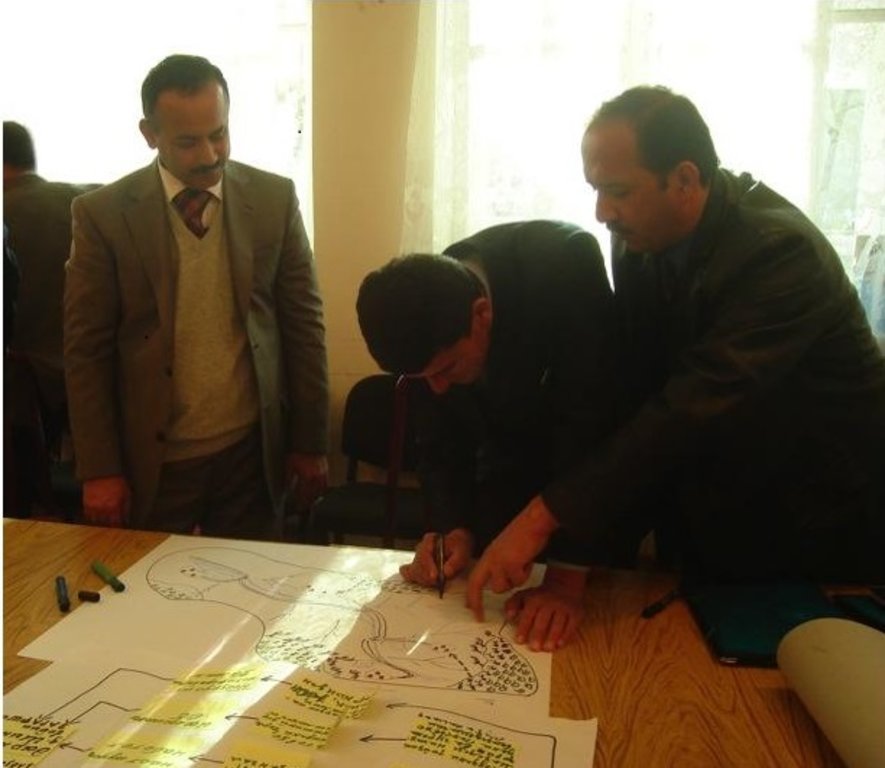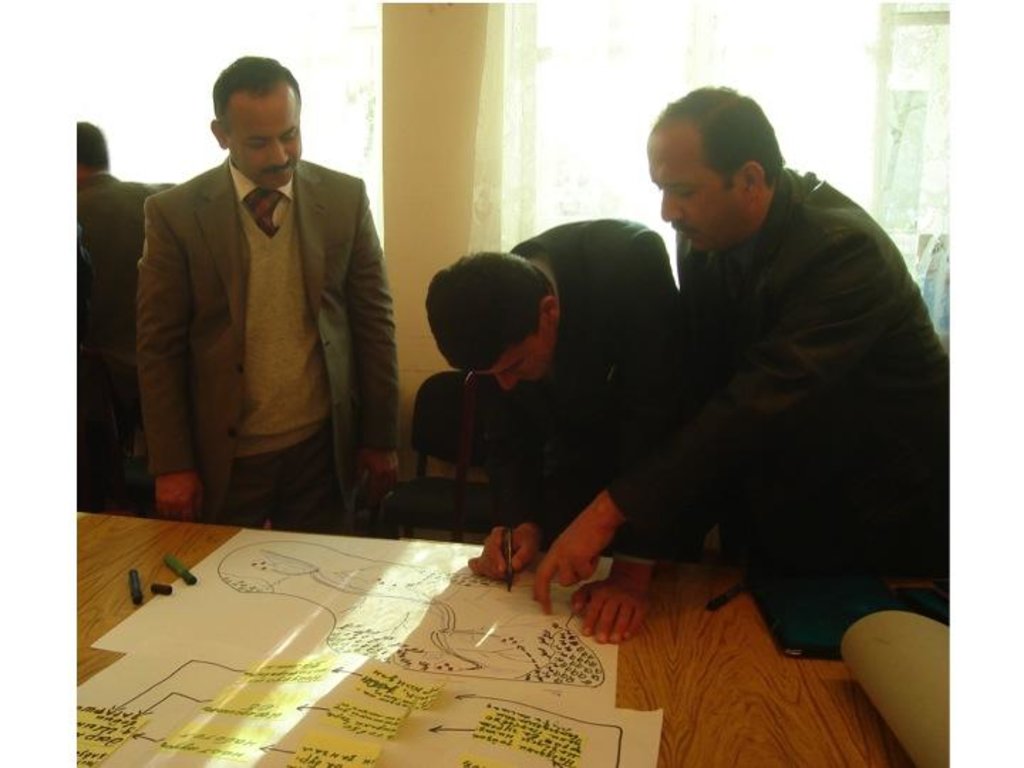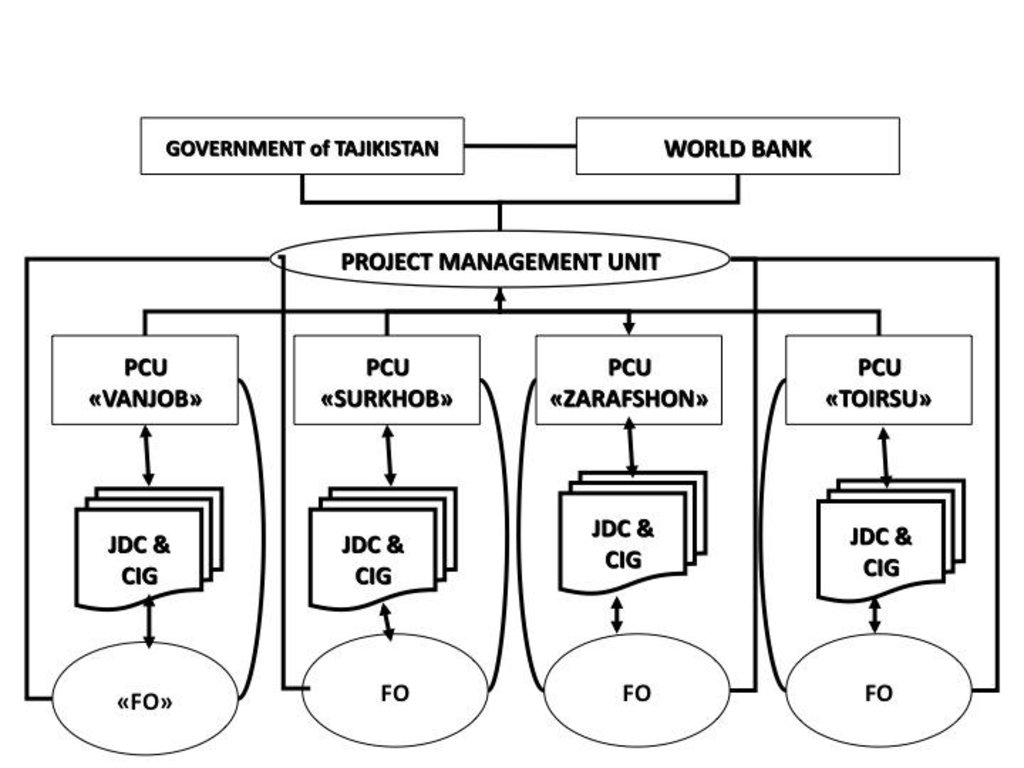Eligibility Criteria and Environmental Planning Tools for SLM [Tajiquistão]
- Criação:
- Atualização:
- Compilador/a: Nandita Jain
- Editor: –
- Revisores: David Streiff, Alexandra Gavilano, Joana Eichenberger
approaches_2578 - Tajiquistão
- Resumo completo em PDF
- Resumo completo em PDF para impressão
- Resumo completo no navegador
- Resumo completo (sem formatação)
- Eligibility Criteria and Environmental Planning Tools for SLM: 2 de Novembro de 2021 (public)
- Eligibility Criteria and Environmental Planning Tools for SLM: 10 de Agosto de 2017 (inactive)
- Eligibility Criteria and Environmental Planning Tools for SLM: 7 de Julho de 2017 (inactive)
- Eligibility Criteria and Environmental Planning Tools for SLM: 7 de Julho de 2017 (inactive)
Veja as seções
Expandir tudo Recolher tudo1. Informação geral
1.2 Detalhes do contato das pessoas capacitadas e instituições envolvidas na avaliação e documentação da abordagem
Especialista em GST:
Mott Jessica
World Bank
Estados Unidos
Nome do projeto que facilitou a documentação/avaliação da Abordagem (se relevante)
Pilot Program for Climate Resilience, Tajikistan (WB / PPCR)Nome da(s) instituição(ões) que facilitou(ram) a documentação/avaliação da Abordagem (se relevante)
World Bank (World Bank) - Estados Unidos1.3 Condições em relação ao uso da informação documentada através de WOCAT
Quando os dados foram compilados (no campo)?
19/11/2007
O compilador e a(s) pessoa(s) capacitada(s) aceitam as condições relativas ao uso de dados documentados através do WOCAT:
Sim
1.4 Referência ao(s) questionário(s) sobre tecnologias da GST
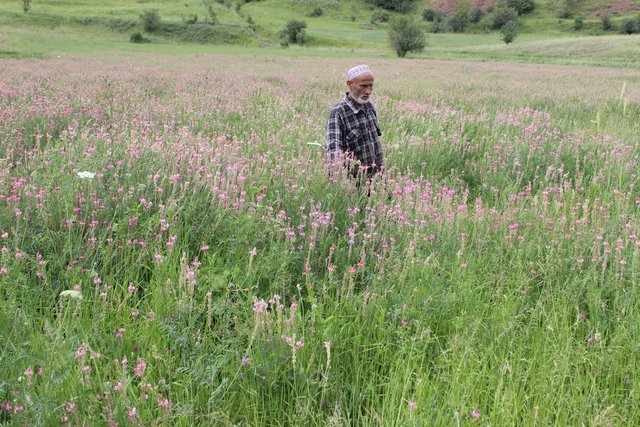
[Tajiquistão]
None
- Compilador/a: MIZROBSHO AMIRBEKOV
2. Descrição da abordagem de GST
2.1 Descrição curta da abordagem
Using eligibility criteria and participatory environmental analyses for selecting and assessing SLM investments.
2.2 Descrição detalhada da abordagem
Descrição detalhada da abordagem:
Aims / objectives: As part of the Community Agriculture and Watershed Management Project (CAWMP), tools were developed to ensure farmers chose appropriate SLM technologies while preparing Community Action Plans (CAPs) and to improve environmental assessments during CAP preparation and in rural investment activities.
Methods: Eligibility Criteria: CAWMP financed small grants for three types of rural production investments: farm productivity, rural infrastructure, and land resource management (the largest type). The eligibility criteria for these grants included meeting at least one of the following impacts on fragile lands: • Prevent/reduce soil erosion • Increase vegetative cover through perennial crops and pasture • Provide soil and moisture conservation • Improve soil quality • Improve water use efficiency • Increase sustainable fodder/wood supply • Increase sustainable renewable energy supply • Increase integrated pest management These criteria ensured an environmental focus, and kept the grant proposals consistent with a list of eligible activities which is critical for a large-scale, community-driven project such as CAWMP. The criteria helped avoid diversion of grant funds to investments not directly related to land sustainability. Combining income-generating investments with environmental criteria encouraged sustainable land use by addressing vital interests of local people. The criteria were used to monitor local environmental impacts. Project arrangements provided for land use right certificates to beneficiaries with Project-financed investments on sloping lands, giving them a stake in the sustained productivity of their land. Traditionally such land use right certificates were issued only for irrigated and other valley areas. The Project financed a total of almost US$ 5.3 million in grants for land resource management, through almost 2,300 subprojects, benefitting over 43,000 households.
Stages of implementation: Participatory environmental analyses. A review of investment proposals and field activities in 2007 revealed that farmers were not capable of properly assessing their local land management problems, identifying the most environmentally appropriate investments or actions, nor monitoring their effectiveness. Tools were developed for project partners and officials to address these concerns including: 1) Developing Conceptual Models of Local Environments/Watersheds; 2) Mapping Local Environments/Watersheds and Associated Threats; 3) Identifying and Ranking Environmental Threats; and 4) Community Environmental Assessment. More than 50 persons attended the two-day interactive training course on the use of the tools. Detailed guidelines for facilitators and trainers to use the tools were prepared in Tajik and Russian. While the training could not influence many of the SLM-related investments already submitted for funding, participants urged that similar training be conducted at the inception of SLM-related projects and that the tools be requirements of SLM planning.
2.3 Fotos da abordagem
2.5 País/região/locais onde a abordagem foi aplicada
País:
Tajiquistão
Região/Estado/Província:
Sughd, RRS, Khatlon, GBAO
Especificação adicional de localização:
Jirgital, Tajikibad, Vanj, Aini, Matcha, Penjikent, Danghara
Comentários:
The Community Agriculture and Watershed Management Project was implemented in four project sites/watersheds - Surkhob, Toirsu, Vanjob and Zarafshan - and included 7 districts/raions and 39 sub-districts/jamoats. The total catchment area was 35,000km2. Total arable, farm and pasture land was approximately 319,500ha
Map
×2.6 Datas de início e término da abordagem
Indique o ano de início:
2005
Ano de término (caso a abordagem não seja mais aplicada):
2012
2.7 Tipo de abordagem
- Baseado em projeto/programa
2.8 Principais metas/objetivos da abordagem
The Approach focused mainly on other activities than SLM (participatory environmental analyses, eligibility criteria, monitoring, assessment, training, guidelines, )
Application of the criteria and tools to help ensure that proposed rural investments in Community Action Plans kept their environmental management focus.
The SLM Approach addressed the following problems: Inappropriate investments with questionable SLM benefits proposed in CAPs. Uneven, sometimes, missing focus on environmental risks and benefits in small grant proposals for rural production investments. Lack of skills in and knowledge of participatory environmental appraisals.
2.9 Condição que propiciam ou inibem a implementação de tecnologia/tecnologias aplicada(s) segundo a abordagem
Quadro institucional
- Inibitivo
Legacy of command-economy focus on infrastructure investments for improving land management and agriculture
Treatment through the SLM Approach: Tools to analyse a range of environmental aspects of land management and propose alternative technologies and approaches, training for project implementers and stakeholders.
Conhecimento sobre GST, acesso a suporte técnico
- Inibitivo
Lack of appropriate analyses of environmental relationships, threats, risks and impacts in choice and design of investment proposals at the village level
Treatment through the SLM Approach: Establishing eligibility criteria, development of participatory learning tools on environmental issues, training for project partners and stakeholders.
3. Participação e papel das partes interessadas envolvidas
3.1 Partes interessadas envolvidas na abordagem e seus papéis
- Usuários de terra/comunidades locais
Jamoat (Sub-district) Development Committees
- Especialistas em GST/ consultor agrícola
Facilitating organization staff, local government specialists, project field staff
- Governo nacional (planejadores, responsáveis pelas decisões)
Project Management Unit (PMU), Project Coordination Units (PCUs)
Caso várias partes interessadas foram envolvidas, indique a agência líder:
PMU
3.2 Envolvimento do usuários de terra/comunidades locais nas diferentes fases da abordagem
| Envolvimento do usuários de terra/comunidades locais | Especifique quem estava envolvido e descreva as atividades | |
|---|---|---|
| Iniciação/motivação | Nenhum | |
| Planejamento | Nenhum | |
| Implementação | Participativo | Villagers used criteria for selecting and designing rural investments. JDCs received training in environmental tools |
| Monitoramento/avaliação | Participativo | Local JDCs assisted in assessment of rural production investments using eligibility criteria as well as other factors. |
| Research | Nenhum |
3.3 Fluxograma (se disponível)
Descrição:
CAWMP - Implementation Arrangements and Project Partners
Autor:
Project Management Unit (Dushanbe)
3.4 Decisão sobre a seleção de tecnologia/tecnologias de GST
Especifique quem decidiu sobre a seleção de tecnologia/tecnologias a serem implementadas:
- Principalmente usuários da terra, apoiados por especialistas em GST
Explique:
Common Interest Group members and technical specialists from the respective facilitating organisation and project coordination unit made decisions on the choice of SLM technologies in rural investments proposed in Community Action Plans. A number of SLM technologies could be used in any one proposal.
Decisions on the method of implementing the SLM Technology were made by mainly by land users supported by SLM specialists. Common Interest Group members and technical specialists from the respective facilitating organisation and project coordination unit made decisions on the method/s for implementing SLM technologies in any one proposal.
4. Suporte técnico, reforço das capacidades e gestão do conhecimento
4.1 Reforço das capacidades/formação
Foi oferecida formação aos usuários da terra/outras partes interessadas?
Sim
Especifique quem foi capacitado:
- Equipe de campo/consultores
- Jamoat (sub-district) Development Committees
Assuntos abordados:
Participatory environmental analyses, assessing rural investments including use of eligibility criteria.
4.2 Serviço de consultoria
Os usuários de terra têm acesso a um serviço de consultoria?
Não
4.3 Fortalecimento da instituição (desenvolvimento organizacional)
As instituições foram fortalecidas ou estabelecidas através da abordagem?
- Sim, moderadamente
Especifique a que nível (níveis) as instituições foram fortalecidas ou estabelecidas:
- Local
Dê mais detalhes:
See TAJ047 on the role and activities of Jamoat (sub-district) Development Committees
4.4 Monitoramento e avaliação
Monitoramento e avaliação são partes da abordagem?
Sim
Comentários:
Use of tools aspects were ad hoc monitored by project staff through observations; indicators: Types of investments proposed, Quality of proposals,
Application of criteria aspects were regular monitored by project staff through observations; indicators: Types of proposals, use in assessment of rural investments
There were no changes in the Approach as a result of monitoring and evaluation: Not directly relevant
There were no changes in the Technology as a result of monitoring and evaluation: No directly relevant
4.5 Pesquisa
A pesquisa foi parte da abordagem?
Não
5. Financiamento e apoio material externo
5.1 Orçamento anual para o componente de GST da abordagem
Caso o orçamento exato seja desconhecido, indique a faixa:
- 10.000-100.000
Comentários (p. ex. principais fontes de recursos/principais doadores):
Approach costs were met by the following donors: international (World Bank and Global Environment Facility): 95.0%; government (Estimate of co-financing ): 5.0%
5.4 Crédito
Foi concedido crédito segundo a abordagem para atividades de GST?
Não
6. Análise de impactos e declarações finais
6.1 Impactos da abordagem
A abordagem auxiliou os usuários da terra a implementar e manter as tecnologias de GST?
- Não
- Sim, pouco
- Sim, moderadamente
- Sim, significativamente
More appropriate investments chosen, criteria contributed to environmental monitoring of rural investments.
Not directly relevant
Did other land users / projects adopt the Approach?
- Não
- Sim, pouco
- Sim, moderadamente
- Sim, significativamente
Interest shown by organisations and projects in participatory tools.
6.2 Principal motivação dos usuários da terra para implementar a GST
- Produção aumentada
- Afiliação a movimento/projeto/grupo/rede
- Consciência ambiental
- well-being and livelihoods improvement
6.3 Atividades de sustentabilidade de abordagem
Os usuários da terra podem manter o que foi implementado através da abordagem (sem apoio externo)?
- Sim
Caso afirmativo, descreva como:
Land-users may require facilitation assistance to conduct environmental analyses, but some individuals and groups may be able to do so independently. Some JDC members may be able to assist. Eligibility criteria along with list of activities can used in other projects or independently by beneficiaries.
6.4 Pontos fortes/vantagens da abordagem
| Pontos fortes/vantagens/oportunidades na visão do usuário da terra |
|---|
| JDCs learned more about environmental relationships, impacts beyond immediate areas, as well as biodiversity aspects of SLM. Also resulted in shifts in thinking about causes of degradation and effects, and so the choice of appropriate activities (How to sustain/ enhance this strength: Ensure that training in the tools, monitoring and related activities are given at the start of projects and programmes.) |
| Pontos fortes/vantagens/oportunidades na visão do compilador ou de outra pessoa capacitada |
|---|
| Criteria were understandable and integrated into monitoring of project rural investments. (How to sustain/ enhance this strength: Disseminate formats for investment monitoring. Criteria can be also be integrated into appraisal stages for rural investments. ) |
| Tools highlighted environmental issues neglected during initial participatory rural appraisals. (How to sustain/ enhance this strength: Continue dissemination of tools, and further refine some tools as needed.) |
6.5 Pontos fracos, desvantagens da tecnologia e formas de superá-los
| Pontos fracos/vantagens/riscos na visão do compilador ou de outra pessoa capacitada | Como eles podem ser superados? |
|---|---|
| Limited impact of tools training due to project implementation schedule. | Provide training in initial stages of projects. |
7. Referências e links
7.2 Referências às publicações disponíveis
Título, autor, ano, ISBN:
Environmental Assessment Templates for Rural Production Investments in CAWMP (2009, English, Russian and Tajik)Tools for Participatory Environmental Analyses (2007, Separate Guidelines for Trainers and Facilitators, English, Russian and Tajik)Eligible and Ineligible Activities for Rural Production Investments in CAWMP (2007, English and Russian)Outline and Assessment for Training in Tools for Participatory Environmental Analyses (2007, English)
Disponível de onde? Custos?
Project Management Unit
Título, autor, ano, ISBN:
Tools for Participatory Environmental Analyses (2007, Separate Guidelines for Trainers and Facilitators, English, Russian and Tajik)
Disponível de onde? Custos?
Project Management Unit
Título, autor, ano, ISBN:
Eligible and Ineligible Activities for Rural Production Investments in CAWMP (2007, English and Russian)
Disponível de onde? Custos?
Project Management Unit
Título, autor, ano, ISBN:
Outline and Assessment for Training in Tools for Participatory Environmental Analyses (2007, English)
Disponível de onde? Custos?
Project Management Unit
Links e módulos
Expandir tudo Recolher tudoLinks

[Tajiquistão]
None
- Compilador/a: MIZROBSHO AMIRBEKOV
Módulos
Não há módulos


